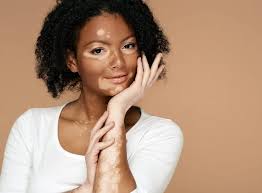
What is it?
For starters, Vitiligo is a skin condition that causes a gradual loss of pigmentation, leading to white patches on the skin. This happens when melanocytes (cells that produce melanin) die or don’t function properly. This is because Melanocytes are responsible for producing skin color. Vitiligo can affect any part of the body, but it is most commonly found in areas that are exposed to the sun, such as the face, hands, and feet.
Development and Causes
Although the cause of this skin condition is still unknown, some suggest that it is an autoimmune disorder where the immune system attacks the melanocytes. Vitiligo can develop slowly over time. While some individuals may experience only a few patches, others may see a widespread loss of pigmentation. In addition, several factors contribute to the development of vitiligo. Such as genetics, autoimmune diseases, and even the environment. Vitiligo can be caused by sunburns or even exposure to chemicals.
Different Types of Vitiligo
There are various types of vitiligo, with different types ranging from covering almost all skin surfaces to only a few areas of the body. Some forms of vitiligo are minor. Which include:
- Segmental: Occurs on only one part or side of the body.
- Localized (focal): Affects a few or just one area of the body.
- Acrofacial: Covers the face and hands, as well as the eyes, nose, and ears.
However, severe cases of vitiligo can cause a more widespread effect, such as:
- Universal Vitiligo: This will affect almost all areas of the body.
- Generalized Vitiligo: Affected areas will continue to progress symmetrically (on similar body parts).
Symptoms
The primary symptom of vitiligo is the appearance of white patches on the skin. These patches vary in size and can spread over time. Some may also experience changes in hair color. In the affected areas (non-pigmented patches), gray or white hair can develop. Alongside this, anyone can be affected by vitiligo regardless of ethnicity or skin type. However, it is often more noticeable in individuals with darker skin. It also usually appears before the age of 20, making young adults and teenagers more prone. Overall, vitiligo is not life-threatening or even contagious.
Possible Treatments
Dermatologists typically treat and diagnose vitiligo. Although there is no cure, these specialists use several different treatment options to manage the condition. This includes: topical corticosteroids, phototherapy, and depigmentation. These treatments aid in reducing inflammation, promoting repigmentation, and stimulating melanocyte activity. However, depigmentation lightens the skin to match the affected areas. Additionally, there is recent research focusing on new treatment options, including the use of JAK inhibitors, which may show promise in helping to restore skin pigmentation. In summary, these treatments can potentially restore color to the skin, but no treatments have been able to prevent vitiligo from continuing to spread.
Effects of Vitiligo
Vitiligo can have a significant emotional impact. It can affect self-esteem and body image. While it is not physically harmful and does not impact life expectancy, the visible nature of the condition can cause distress. Additionally, people with vitiligo might experience a higher risk of sunburn, hearing loss, and eye problems.
Sources
https://www.jdsjournal.com/article/S0923-1811(23)00271-2/fulltext
https://health.ucdavis.edu/dermatology/specialties/medical/vitiligo.html
https://www.niams.nih.gov/health-topics/vitiligo
https://my.clevelandclinic.org/health/diseases/12419-vitiligo
https://www.mayoclinic.org/diseases-conditions/vitiligo/symptoms-causes/syc-20355912#